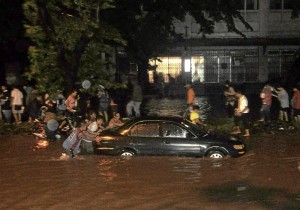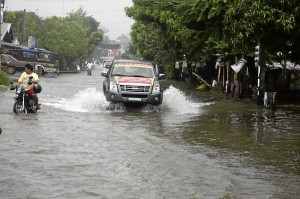The skinny on myths about flood driving
I just recently celebrated my birthday, which means it’s the rainy season. On a bad year, either a volcano erupted or a major earthquake happened somewhere but usually just heavy rain, which nevertheless keeps everybody from leaving the party. Since rains and floods are already here, it’s time to debunk some driving in the flood myths.
Myth 1: If you drive into a flood, turn off the air conditioner.
Skinny: True. According to 4×4 expert Beeboy Bargas, turning off the air conditioner in the older model cars was important because they didn’t have a separate clutch fan. The engine has a solitary fan, which works with a pulley connected to all the system. Turning off the air conditioner decreases the chances of damaging the system. For newer models, floodwater can short out the electrical parts of the car resulting in more heart and headaches than a few sauna-like minutes in your newfound submarine.
Myth 2: An SUV is an amphibian.
Skinny: False. Even if they are as rugged and high, the S in SUV does not mean submarine. The advantage of an SUV is usually the air box (where air comes in to the engine—which is used to burn fuel) is higher than the usual sedans, it is still prone to water damage. You can usually see this air intake near the inside fender. The air is important in the fuel. It is also important in the air combustion process, which keeps the engine on, therefore producing a force that expels the water from the muffler, which is another entry point for water.
Article continues after this advertisementMyth 3: …and so is the pick-up.
Article continues after this advertisement
HALF a meter of floodwater is enough to sweep a car off the road and into an even more dangerous area.
Skinny: False. Pick-ups are also not amphibians. They might be horses because they usually have a higher wheelbase and/or bigger tires that are helpful in these conditions. The 4×4 vehicles that you see crossing rivers usually have an air scoop, whichis installed to raise the entry point of air into the engine higher up in the vehicle and ensuring that the fuel and air combustion in the engine continues.
Myth 4: You need to step on the accelerator continuously (while driving through floodwater).
Skinny: Partially. Stepping on the accelerator increases this force that makes sure that water does not come into the engine through the muffler. But you don’t need to overdo it. As long as the engine is on, the outward force will continue to come out of the muffler, expelling the water in the process.
Myth 5: If it’s just about knee-high, it is safe to drive.
Skinny: False. According to Floodready.com, only half a meter of floodwater is enough to sweep a car off the road. There are other factors that you don’t see under the murky waters that can turn your EDSA drive into a white-water rafting experience.
Myth 6: High water is the only danger.
Skinny: False. During the rain, a lot of debris are washed away from our sooo clean streets (I am being sarcastic here). There is a possibility that items that can either puncture your tire or put a dent in your car, such as floating trashcans, woods, pieces of metal, Godzilla, etc., are lurking under the waters.
Myth 7: Pump your brakes after passing through water.
Skinny: True. My husband (JP Tuason), who teaches defensive driving, always mentions this during his seminars. Pumping the brakes dries the brake pads because a wet braking system is unresponsive and this is a recipe for a crash.
Myth 8: When flooded, drive at the center of the road.
Skinny: True. According to Mike Johnson, owner of Trapik.com, most of the roads are crowned, making the center the highest part of the road. This may sound very bitchy, but, hey, I don’t think there’s a lot of you that will attempt this anyway.
So now that we have debunked some of the myths, please don’t claim that you have not been informed. A great philosopher once said: “And knowing is half the battle”… wait I think that was GI Joe.
For comments and suggestions, please e-mail me at [email protected]. Please e-mail us your tips in driving safe during the rainy season. The top 10 best tips will get Ford’s First Gear Book for New Drivers.
